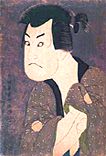 |
 |
 |
 |
 |
 |
|||||
 |
 |
 |
 |
|
MASTER IN DISGUISE: Professor Sheds Light on Mystery Ukiyo-e Artist March 23, 1999   In these two portraits of the same actor by Sharaku (left) and Hokusai, the faces are depicted very similarly. (Tokyo National Museum) In the late eighteenth century, a woodblock print artist named Toshusai Sharaku burst onto the scene and shocked the Japanese art world with his unconventional style. A mere 10 months later he disappeared without a trace. Over the years various hypotheses have been put forward concerning the artist's true identity. One art historian, professor Hidemichi Tanaka of Tohoku University, will soon present a paper offering evidence that the mysterious Sharaku is none other than Katsushika Hokusai. Since Hokusai is generally regarded as one of the greatest woodblock print artists ever, this latest proposition is stimulating considerable interest and debate. Mystery Artist Sharaku appeared on the scene in 1794 and over a brief 10-month period produced some 140 prints featuring kabuki actors and sumo wrestlers almost exclusively. He vanished without a trace almost as quickly as he appeared, triggering questions about the artist's true identity. Sharaku's works differed from conventional prints in that they featured the actors in exaggerated, almost grotesque poses that went beyond traditional artistic representations and depicted their true personas. The works caused an outcry among the public, and were not well-received. Only much later did the pieces gain a devoted following. Who was Sharaku? Up to now as many as 40 names have been given as possible explanations. For some, this riddle is almost as intriguing as the prints themselves. The most recent hypothesis suggests that Sharaku is actually Katsushika Hokusai, whose masterpieces include Thirty-six Views of Mt. Fuji and Sketches by Hokusai. Hokusai is considered, along with such notables as Kitagawa Utamaro and Ando (Utagawa) Hiroshige, one of the great masters of the genre. His works are known to have influenced, among others, the French impressionists and Vincent van Gogh. Sharaku's appearance coincided with a period in which Hokusai was inactive. Though others have made this connection in the past, this is the first time that an art historian has sought to solve the riddle of Sharaku's identity through scholarly research. Professor Tanaka felt that theories relating to this mystery up to now have relied too heavily on historical data and set about looking for clues in the works themselves. He conducted a detailed comparative analysis of the two artists' styles, and his paper is based on his findings. Close Examination Tanaka points out that since samurai images are based on actual historical events, the artist has less room to take license with the subject matter; therefore, personal stylistic tendencies are more easily distinguishable. "Hokusai is seen as having taken great care to hide the fact that he was Sharaku, but ironically, he was unable to conceal his style in the samurai prints. In a comparative analysis, the lines and gestures of the figures and their facial expressions indicate clear similarities." Tanaka is not an expert on ukiyo-e, but has spent many years comparing styles in Western art and has lent his expertise in appraising the value of many Japanese works as well. "In Japanese art history up to now there has been very little in the way of stylistic comparison of specific works. My analysis is one such examination. From a specialist's perspective, I am confident that there is no mistake. If supportive documentary research were to bear out these findings, I think it would become an accepted theory." If Sharaku is indeed proven to be Hokusai, it will solve one of the greatest lingering mysteries in Japan's art history.
|

